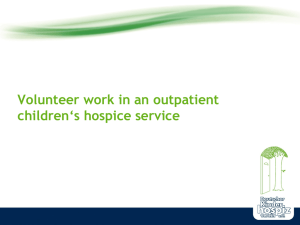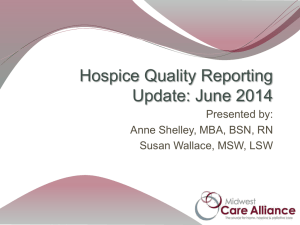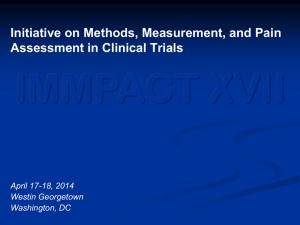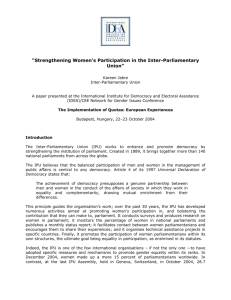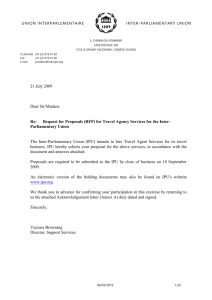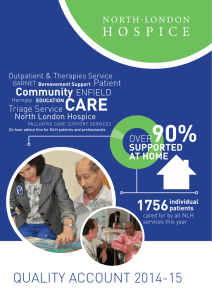A new tool for assessing pain in hospice patients who can`t self
advertisement
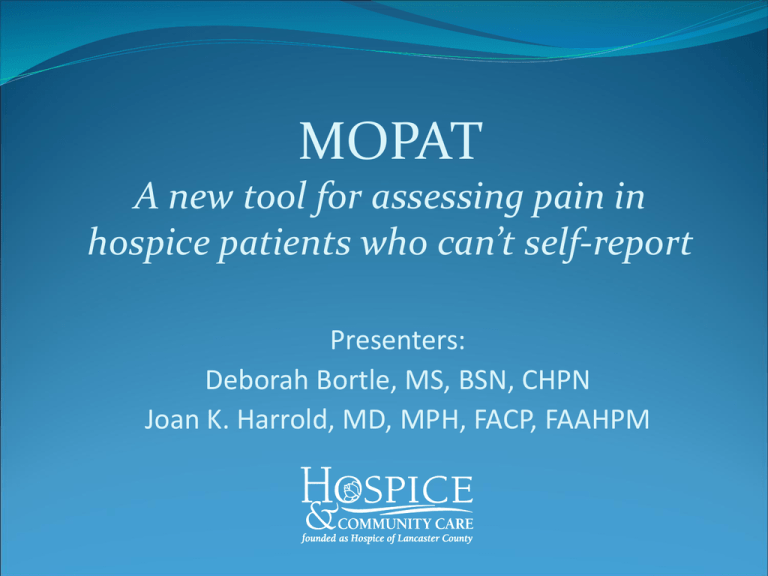
MOPAT A new tool for assessing pain in hospice patients who can’t self-report Presenters: Deborah Bortle, MS, BSN, CHPN Joan K. Harrold, MD, MPH, FACP, FAAHPM Pain Assessment in Hospice Patients Patients able to self-report Patients not able to self-report How do we it? What are the challenges? What do we need? MOPAT: Multidimensional Objective Pain Assessment Tool University of Maryland School of Nursing Preliminary work (McGuire & Reifsnyder, 2004) suggested that at least 2 dimensions of acute pain— behavioral and physiologic—could be assessed in noncommunicative palliative care patients. Goal: to validate the MOPAT and demonstrate its feasibility in a spectrum of palliative care settings when used by both nurses and informal caregivers to assess acute pain in non-communicative patients. MOPAT Hospice of Lancaster County ADC 450-500 12 bed IPU, mainly GIP Second IPU opened, 16 beds, mainly GIP Research MS/BSN 0.5 FTE On-site IS manager to enable EMR data collection MOPAT in Hospice Remove blood pressure measurements Not routinely performed, especially at EOL Could limit future clinical utility Staff other than nurses Other caregivers Study Design Eligible IPU patients suspected of having pain Simultaneous MOPAT assessments by Study RN and Staff nurse (RN or LPN) 1 primary Study RN with 1 back-up Reassessment following intervention Timing based on intervention used Staff MOPAT results documented in EMR Study MOPAT results not included in patient record Serial values were used clinically even if not recorded for the study Inclusions/Exclusions Inclusion Adults with evidence of pain and not able to self-report Exclusions Non-responsive Pediatric < 18 years old RAST < 5 Any diagnosis of dementia MOPAT Behavioral Subscale Behavioral Pain Indicators 0 (None or Normal) 1 (Mild) 2 (Moderate) 3 (Severe) Restless Quiet Slightly restless (fidgety) Moderately restless (tossing/turning) Very restless (agitated, constant movement) Tense Muscles Relaxed Slight tenseness (Guarding) Moderate tenseness (sensitivity or mild resistance to movement) Extreme tenseness (stiffness or total body rigidity) No frowning or grimacing Slight frowning or grimacing (furrowed brow) Moderate frowning or grimacing Constant frowning or grimacing Quiet Sighs, groans, moans softly Groans, moans loudly Cries out or sobs (Muscle Tension) Frowning/Grimacing (Facial Expression) Patient Sounds (Vocalization) S (Record ‘4’ if unable to vocalize) Behavioral Score Physiological Subscale Physiological Pain Indicators 0 (Usual or No Change from Usual) 1 (Not Usual or Change from Usual) Heart Rate Usual/No Change Change from usual Respirations Usual/No Change Change from usual Diaphoresis Usual/Absent Present S Physiological Score TOTAL SCORE Recruitment and Education Hospice decided MOPAT to be used in IPU for all patients Regardless of patient enrollment in study Every IPU nurse trained on MOPAT MOPAT Incorporated into IPU EMR UMd created a video of case scenarios Revised for hospice environment Unit Director volunteered to be patient in video Researchers and IPU leaders performed consensus ratings prior to use for training Training Trained staff over 3 months 39 RNs and 22 LPNs agreed to participate in study 1 RN and 1 LPN declined, but still utilized MOPAT Same instructor for everyone Out of the IPU for training Associated color: PURPLE magnets Included snacks Thank you gift: MOPAT clipboard Feedback via fliers when general issues identified Clinical Utility Assessment Completed monthly by nurses who volunteered to participate in this arm of study No additional incentives Did nurses like the tool? Would they use the tool? Patient Enrollment Project began March 7, 2009 Nurses had 3-5 months to use before enrollment patient 50 patients enrolled by December 11, 2009 Last patient enrolled November 23, 2010 21 month enrollment period for 100 patients Challenges to Enrollment IPU transfers 5pm-8am and on Saturdays Opening of new IPU 7 miles away Reasons not enrolled: 50% diagnoses included dementia 22% died prior to study assessment 20% died before re-assessment 2% study nurse not available 2% RAST < 5 Results: Nurses using MOPAT 100 80 60 40 20 0 M ar t p Se M ar t p Se Results: Return Rate CUQ’s (%) 100 80 60 40 20 ep t S ar M ep t S M ar 0 Results of MOPAT in Hospice Reliability Agreement between Study nurse and Staff Nurse raters was significant at p<.001, with moderate-substantial agreement on most indicators. Validity Validity was evidenced by statistically significant (p<.001) reductions in behavioral, physiologic, and total MOPAT scores following pain interventions. Clinical Utility Questionnaire 1. MOPAT took a reasonable amount of time to complete. 2. MOPAT was easy to use. 3. MOPAT would be feasible for regular use in my clinical setting. 4. MOPAT was easy for me to understand. 5. MOPAT guided me in what to look for when assessing pain. 6. MOPAT assisted me in communicating to others about a patient’s pain. 7. MOPAT was helpful in determining the presence of pain in a non-communicative patient. 8. MOPAT was helpful in determining whether a patient might need a pain intervention. 9. MOPAT could be used by informal caregivers (family, friends) with some training. Strongly Disagree Disagree Undecided Agree Strongly Agree 1 2 3 4 5 1 2 3 4 5 1 2 3 4 5 1 2 3 4 5 1 2 3 4 5 1 2 3 4 5 1 2 3 4 5 1 2 3 4 5 1 2 3 4 5 Results: Utility Guided pain assessment Assisted in communication Helped determine if pain present Helped determine intervention needed 63.9% 61.1% 61.6% 60.3% Results: Ease of Use Reasonable time to complete Easy to use Feasible for regular use Easy to understand 63.8% 71.5% 57.3% 71.8% Adjustments to MOPAT Eliminate diaphoresis on MOPAT tool Added no value Shortened time to complete Home Hospice Roll-out Roll out to admission team first Tried to get their feedback before HH roll out Easier to use than they expected Liked an objective tool Didn’t like having another form to complete Recognized need for standardized tool for patients with dementia who cannot self-report Dementia in IPU accounted for 50% of those excluded from MOPAT study PAINAD added to EMR prior to HH roll-out Home Hospice Training Power point presentation in IDT plus make-up sessions All IDT members included Written case scenarios for selection of appropriate tool MOPAT and PAINAD tools in handouts Flow chart on how to document your pain assessment Self report—if unable, choose either… PAINAD MOPAT Issues in Home Hospice Nurses using assessment tools interchangeably Even for same patient More than expected from fluctuations in clinical status Using self-report while awake and MOPAT while asleep Using MOPAT and PAINAD for same patient Nurses only using a tool after they determine patient has pain Need to use to help determine if a patient has pain Allows next clinician to compare pain levels using same variables Communication, not clinical accuracy Issues in Home Hospice Definition of dementia 34.8% with dementia had a MOPAT completed Emphasize self-report first! What constitutes a diagnosis of dementia? Problem or dx list? Family report? Clinical notes? Timing of focus on NQF #0209 Comfort in 48 hours Self-report only Diminished focus on assessment of patients who cannot self-report Lessons Learned Roll-out with fanfare Need excitement to make an impression Don’t roll-out with too many other new things Use the video scenarios in all training Ask for feedback Can use the CUQ, but not every month! Deliver rapid feedback to teams on MOPAT use Develop organizational policy regarding dementia diagnosis Future Directions Use CUQ’s to get nursing feedback in Home Hospice Beginning January 2013 Explore use by other caregivers Nursing home clinicians Caregivers at home CUQ: MOPAT could be used by informal caregivers 1.9% disagree 39.8% undecided 58.2% agree Appreciation to Our Colleagues Deborah McGuire, PhD, RN, FAAN Principal investigator Karen Kaiser, PhD, RN-BC, AOCN Karen Soeken, PhD JoAnne Reifsnyder, PhD, ACHPN

